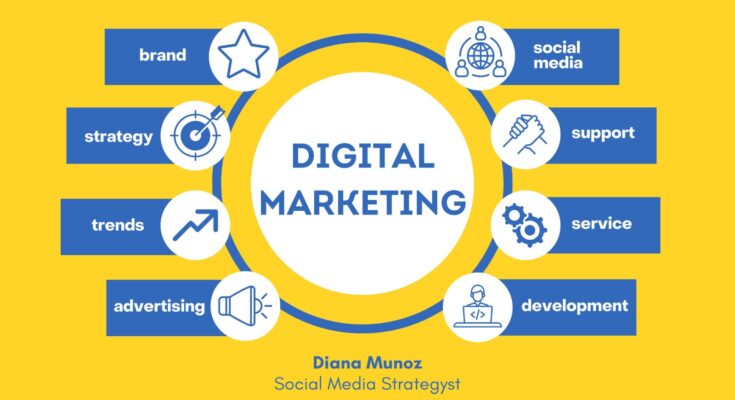The Evolving Landscape of Marketing & Advertising
Strategies for Success
Marketing and advertising have always played a crucial role in business growth and brand building. However, in today’s fast-paced, digital world, the landscape of marketing and advertising is constantly evolving. With the rise of social media, advancements in technology, and changing consumer behaviors, marketers need to adapt their strategies to stay relevant and achieve success. In this article, we will explore the key trends and strategies that define the modern marketing and advertising landscape.
- Embracing Digital Transformation
Digital transformation has revolutionized the way businesses approach marketing and advertising. Traditional methods such as print ads and billboards are being replaced by online platforms, search engines, social media, and mobile advertising. Brands must invest in a strong online presence, optimize their websites for search engines, and leverage social media platforms to engage with their target audience effectively.
- Personalization and Customer-Centricity
Today’s consumers expect personalized experiences. Generic mass advertising no longer holds the same power it once did. Marketers must harness the wealth of customer data available to deliver targeted, relevant messages and offers. By leveraging data analytics and artificial intelligence, brands can understand their customers’ preferences and behavior, enabling them to tailor their marketing efforts and create meaningful connections.
Influencer marketing has become a powerful tool in the modern marketing arsenal. Consumers increasingly trust recommendations from influencers they follow on social media platforms. Brands collaborate with influencers who align with their values and target audience, leveraging their credibility and reach to promote their products or services. This approach allows businesses to tap into niche markets and foster authentic connections with potential customers.
- Content Marketing and Storytelling
In the age of information overload, businesses must cut through the noise and capture consumers’ attention. Content marketing focuses on creating valuable, relevant, and engaging content that educates, entertains, or solves a problem for the audience. Storytelling is a key element of content marketing, allowing brands to emotionally connect with consumers. By crafting compelling narratives and delivering them through various mediums such as blogs, videos, podcasts, and social media, businesses can establish thought leadership and build trust with their audience.

- Data-Driven Decision Making
Data has become the lifeblood of effective marketing and advertising. By leveraging analytics tools, businesses can track and measure the performance of their campaigns, gain insights into consumer behavior, and optimize their marketing strategies accordingly. Data-driven decision making allows marketers to allocate resources more efficiently, identify areas for improvement, and stay ahead of the competition.
- Authenticity and Transparency
In an era where consumers are more discerning than ever, authenticity and transparency are paramount. Consumers value brands that are genuine, ethical, and socially responsible. Marketers must ensure their messaging aligns with their brand values and deliver on their promises. Building trust through transparent communication fosters long-term customer loyalty and positive brand perception.
- Mobile Marketing
The widespread adoption of smartphones has made mobile marketing an essential aspect of any comprehensive marketing strategy. Marketers must optimize their websites for mobile devices, create mobile-friendly content, and invest in mobile advertising to reach consumers who spend a significant amount of time on their phones. Location-based marketing, mobile apps, and SMS marketing are also effective ways to engage with the mobile-savvy audience.
- Social Media Advertising
Social media platforms such as Facebook, Instagram, Twitter, and LinkedIn have become integral to marketing and advertising efforts. These platforms offer powerful targeting options and robust analytics tools that allow businesses to reach their desired audience with precision. Marketers must develop social media strategies, create engaging content, and leverage social media advertising features to increase brand awareness, drive website traffic, and generate leads.
- Video Marketing
Video has emerged as a dominant form of content consumption, with platforms like YouTube, TikTok, and Instagram Reels experiencing exponential growth. Video marketing offers an immersive and visually appealing way to engage with consumers. Marketers should invest in creating high-quality, engaging videos that tell stories, showcase products or services, provide tutorials, or entertain the audience. Live streaming and interactive video formats can further enhance the audience’s engagement and drive conversions.
- Customer Experience and Relationship Management
Marketing and advertising extend beyond the initial sale. Businesses must focus on delivering exceptional customer experiences and building long-term relationships with their customers. By prioritizing customer service, personalization, and post-purchase engagement, marketers can cultivate brand advocates who will not only become repeat customers but also spread positive word-of-mouth recommendations.
- Automation and AI
Automation and artificial intelligence (AI) have transformed the marketing landscape by streamlining processes, improving efficiency, and enhancing customer experiences. Marketers can leverage AI-powered tools and chatbots to automate repetitive tasks, personalize messaging at scale, and provide real-time customer support. Additionally, AI can analyze vast amounts of data to uncover actionable insights and optimize marketing campaigns.

- Integrated Marketing Communications
Integrated Marketing Communications (IMC) emphasizes the importance of delivering consistent messaging across multiple channels and touchpoints. Marketers should strive for synergy among various marketing activities, such as advertising, public relations, social media, content marketing, and events, to create a unified brand experience. An integrated approach ensures that every interaction with the brand reinforces its core values and strengthens the overall marketing efforts.
- Ethical Considerations
In an era of heightened consumer awareness, ethical considerations play a significant role in marketing and advertising. Marketers must be mindful of privacy concerns, data security, and responsible data usage. Additionally, adhering to ethical advertising standards, avoiding deceptive practices, and being transparent in data collection and usage build trust and credibility with consumers.
- Agile Marketing
Agile marketing involves embracing flexibility and adaptability in marketing strategies. Marketers should continuously monitor and analyze performance metrics, stay updated with industry trends, and be open to adjusting their strategies based on feedback and insights. By adopting an agile approach, marketers can respond quickly to market changes, test new ideas, and optimize their campaigns for better results.
Conclusion
The field of marketing and advertising is ever-evolving, presenting both challenges and opportunities for businesses. By embracing digital transformation, personalization, influencer marketing, content marketing, data-driven decision making, authenticity, and transparency, marketers can build successful campaigns that resonate with their target audience. Additionally, leveraging mobile marketing, social media advertising, video marketing, customer experience management, automation, integrated communications, ethical practices, and adopting an agile mindset will ensure long-term growth and competitiveness in the dynamic marketing landscape.
Marketing and advertising have transformed significantly in recent years, driven by technological advancements and changing consumer expectations. To thrive in this dynamic landscape, businesses must adapt their strategies to leverage digital channels, personalize their messaging, harness the power of influencers, create compelling content, make data-driven decisions, and prioritize authenticity and transparency. By embracing these trends and adopting innovative approaches, marketers can effectively reach their target audience, build meaningful connections, and drive business growth in today’s highly competitive marketplace.


7,8,9 I already interested the process can you teach me More on how to proceed…to the next to earned
Hi
Hi
hi
Hi
Anit Khan890
تمنا ان يعجبكم متواي
Sir mujhe likes chaye
Likes chaye please🙏 10000
umargondal899@gmail.com
Hi! please follow me on TikTok John lourence Manuel Bartolome
Mujhy likes chaiye plzzzzzzzzzzz 2 million krdilo plzzzzz
Like plzz
A lm almost like and followers
Plz like and followers
Hi
Jimmy khan 697
Sir mujhy like chahey
This app is good for me
More followers
😌😌😌😌😌😌😌
I GET A MORE FOLLOWERS AND LIKES
umargondal899@gmail.com
I’m get followers and likes
I hope it will work for me to grow.
I need job
Nice
Plz like me all vidaos bro
My name is Ahmad khan
My name is Ahmad khan Im muslims
I want to more followers
Mujhe followers and likes and comments
I want more followers please.
I want followers please 🥺
1k follower
I want more followers
I am interested
Followers
Help me to have a lot of viewers and raectors in my tiktok😍
Free like
Muhammad Hamza Baghdad Iraq
پلیز فوریو
I need digital marketing
Plz like my vidaos all bro
I want to likes and followers on tiktok plz
Grow my tiktok account
Like my id dreshak
Hi mam
umargondal899@gmail.com
Uuu
Pls increase likes and follower on Instagram I mention my id ___shalu__chandra
Mujy like chaiy
Please mujy like chaiy
Mujhy likes chaiye plzzzzzzzzzzz 2 million krdilo plzzzzz
No comment 😅
More followers and Like
10000000 followors